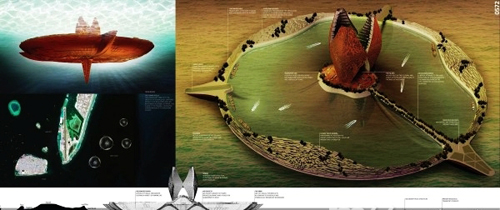漂浮的马尔代夫国家可以看作是由一系列的岛屿组成,但想要利用浮力建造一定高度的建筑,可为工程力学的奇迹。每个摩天大楼到直插云霄,高于海平面1000米,而地基也伸入海平面1000米以下,使居住面积达到马来西亚国家石油工资双塔建筑容纳人数的56倍,同时还要保持首都城市马累的密度。随着人口的增长,可以为这座建筑增加更多的模块,增加建筑的高度,扩大建筑网络,就像土地开垦那样,只不过这是漂浮着的。

With an average ground level of 1.5 m from the sea level, Maldives is the lowest county on the planet, with its highest point topping off at only 2.3 m above sea level.
The country is in a dire situation as sea levels are set to rise to 59 cm above the sea level in the year 2100. This rate would probably be accelerated if natural disasters are to be accounted for. The 2004 tsunami affected many of Maldives’ inhabited islands, where only 9 islands managed to escape flooding. 57 islands faced serious damage to its infrastructure, 14 needed to be completely evacuated and 6 were decimated.
Physical destruction aside, the flooding of Maldives would also signal the obliteration of the proud Maldivian culture, as well as a complete loss of her people’s sense of self and sovereignty.
While plans have been made to buy land in India, Sri Lanka and Australia to keep the country going, this essentially makes the people of Maldives strangers in strange lands. It is perhaps conceivable that this nation of 400,000 people can live in vertical structures floating in its own waters. That way, the legacy and memory of the Maldives can live on, albeit in a vastly different iteration. At the same time, the republic in this new form can continue to be sustained by its famed tourism industry.
The Floating States of Maldives can be recognized still as a series of islands, but are essentially engineering marvels of buoyancy and height. The network of towers soar to a maximum of 1000m above sea level and their keels dive 1000, below, accommodating floor areas of up to 56 times that of the combined Petronas Twin Towers, while maintaining the density of its capital city, Male. As the population increases, more modules can be added to the structure, increasing the towers’ heights and expanding the network, like land reclamation, only floating.




 cityup.org 传真电话:010-88585380
cityup.org 传真电话:010-88585380